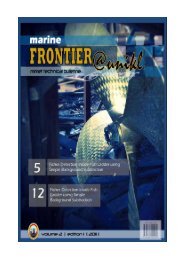click here to download - UniKL MIMET Official Website
click here to download - UniKL MIMET Official Website
click here to download - UniKL MIMET Official Website
Create successful ePaper yourself
Turn your PDF publications into a flip-book with our unique Google optimized e-Paper software.
used <strong>to</strong> model the pneumatic transmission line<br />
Tannehill et al. (1997), which combines the<br />
lumped model (Xue and Yusop, 2005) <strong>to</strong> simulate<br />
the air dynamics in the transmission line. The<br />
experiment set‐up is shown in Figure 1.<br />
Figure 1: Experiment Set‐Up<br />
The valve is opened until the transmission line<br />
reaches a steady state. The valve is then closed<br />
and the system is allowed <strong>to</strong> reach a different<br />
steady state. Pressure transducers are used <strong>to</strong><br />
record the pressure during this process. At the<br />
same time a mass flow meter is used <strong>to</strong> record<br />
the steady state mass flow rate. The simulation<br />
is then performed <strong>to</strong> verify the transient proc‐<br />
ess of the fluid in the transmission line after the<br />
valve is fully closed.<br />
The blocked transmission line is considered <strong>to</strong><br />
have N number of segments. Hence N numbers<br />
of pressure transducers are needed <strong>to</strong> capture<br />
the changes in air pressures along a 4m polyure‐<br />
thane pneumatic transmission line which has an<br />
internal diameter of 5.0mm and a thickness of<br />
1.5mm. The change in system temperature is not<br />
considered in this study and the temperature is<br />
assumed <strong>to</strong> be constant at an ambient tempera‐<br />
ture of 20°C. The change in transmission line di‐<br />
ameter due <strong>to</strong> high system pressure is consid‐<br />
ered during the simulation.<br />
<strong>MIMET</strong> Technical Bulletin Volume 1 (2) 2010<br />
MATHEMATICAL MODEL<br />
For a general three‐dimensional Navier‐S<strong>to</strong>kes<br />
equation, the following assumptions are made:<br />
1. The swirl of the working fluid in each cross sec‐<br />
tion along the transmission line is omitted.<br />
2. The change in fluid properties along the radial<br />
direction is omitted.<br />
3. Perfect gas is considered ‐<br />
The equations are then reduced <strong>to</strong> one‐dimensional<br />
format as follows:<br />
For continuity equation:<br />
��<br />
�<br />
�t<br />
�<br />
�x<br />
��u��0 x<br />
and for momentum equation:<br />
p � � RT<br />
w<strong>here</strong> ρ is the density, ux being the velocity<br />
along the axial direction, p is the pressure, R is<br />
the gas constant, T is the system temperature<br />
and μ is the dynamic viscosity.<br />
(1)<br />
(2)<br />
| MARINE FRONTIER @ <strong>UniKL</strong><br />
107



